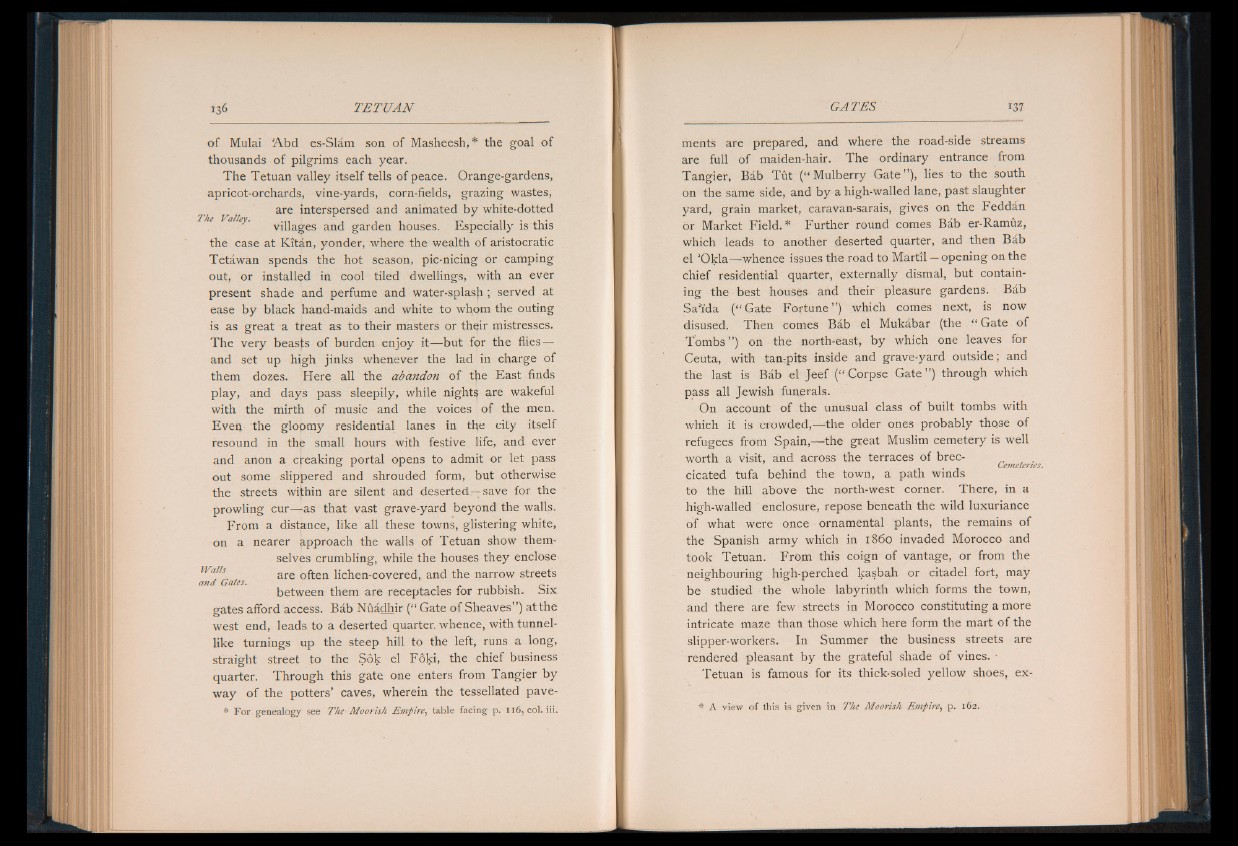
of Mulai A b d es-Slam son of Masheesh, * the goal of
thousands of pilgrims each year.
The Tetuan valley itself tells of peace. Orange-gardens,
apricot-orchards, vine-yards, corn-fields, grazing wastes,
are interspersed and animated by white-dotted
The Valley. ... v , . T. . „ . . . .
villages and garden houses. Especially is this
the case at Kitan, yonder, where the wealth of aristocratic
Tetawan spends the hot season, pic-nicing or camping
out, or installed in cool tiled dwellings, with an ever
present shade and perfume and water-splasji; served at
ease by black hand-maids and white to whom the outing
is as great a treat as to their masters or their mistresses.
The very beasts of burden enjoy it— but for the flies —
and set up high jinks whenever the lad in charge of
them dozes. Here all the abandon of the East finds
play, and days pass sleepily, while nighty are wakeful
with the mirth of music and the voices of the men.
Even the gloomy residential lanes in the city itself
resound in the small hours with festive life, and ever
and anon a creaking portal opens to admit or let pass
out some slippered and shrouded form, but otherwise
the streets wi|thin are silent and deserted—save for the
prowling cur— as that vast grave-yard beyond the walls.
From a distance, like all these towns, glistering white,
on a nearer approach the walls of Tetuan show themselves
crumbling, while the houses they enclose
^anl^Gaies are often lichen-covered, and the narrow streets
between them are receptacles for rubbish. Six
gates afford access. Bab Nuadhir (“ Gate of Sheaves” ) at the
west end, leads to a deserted quarter, whence, with tunnellike
turnings up the steep hill to the left, runs a long,
straight street to the Sok el Foki, the chief business
quarter. Through this gate one enters from Tangier by
way o f the potters’ caves, wherein the tessellated pave-
-s For genealogy see The Moorish lini'pire. table facing p. 116, col. iii.
ments are prepared, and where the road-side streams
are full of maiden-hair. The ordinary entrance from
Tangier, Bab Tut (“ Mulberry Gate ” ), lies to the south
on the same side, and by a high-walled lane, past slaughter
yard, grain market, caravan-sarais, gives on the Feddan
or Market Field.* Further round comes Bab er-Ramuz,
which leads to another deserted quarter, and then Bab
el ’Okla— whence issues the road to Martil — opening on the
chief residential quarter, externally dismal, but containing
the best houses and their pleasure gardens. Bab
Sa’ida (“ Gate Fortune” ) which comes next, is now
disused. Then comes Bab el Mukabar (the “ Gate of
Tombs” ) on the north-east, by which one leaves for
Ceuta, with tan-pits inside and grave-yard outside; and
the last is Bab el Jeef (“ Corpse G ate” ) through which
pass all Jewish funerals.
On account of the unusual class of built tombs with
which it is crowded,— the older ones probably those of
refugees from Spain,— the great Muslim cemetery is well
worth a visit, and across the terraces of brec- 6 emetent
cicated tufa behind the town, a path winds
to the hill above the north-west corner. There, in a
high-walled enclosure, repose beneath the wild luxuriance
o f what were once ornamental plants, the remains of
the Spanish army which in i860 invaded Morocco and
took Tetuan. From this coign of vantage, or from the
neighbouring high-perched kasbah or citadel fort, may
be studied the whole labyrinth which forms the town,
and there are few streets in Morocco constituting a more
intricate maze than those which here form the mart o f the
slipper-workers. In Summer the business streets are
rendered pleasant by the grateful shade of vines. •
Tetuan is famous for its thick-soled yellow shoes, ex-
A view of this is given in The Moorish Empire| p. 162.